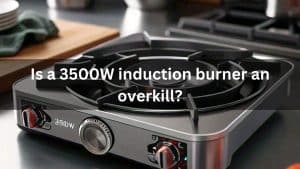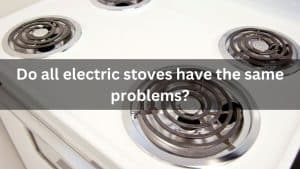Unraveling the Mystery!**When it comes to cooking, induction stoves are often hailed as the modern chef’s best friend, offering precision and efficiency that traditional methods just can’t match. But have you ever stopped to wonder about the technology behind this culinary marvel?
As we explored electromagnetic fields and electrical engineering, a burning question arose: Are induction stoves considered inductive loads? In this post, we’ll unravel this intriguing topic while exploring how these sleek appliances work their magic in your kitchen. Get ready to transform your understanding of induction cooking—let’s ignite those curiosity sparks!
Table of Contents
The Mystery of Induction Stoves
Induction stoves have been gaining popularity in recent years for their innovative technology and energy efficiency. However, there still remains a mystery surrounding these appliances – are they considered inductive loads? To understand this phenomenon, we first need to understand the basic functioning of an induction stove.
An induction stove works by using an electromagnetic field to directly heat up the cookware placed on it. This is vastly different from traditional stovetops that use radiant heat to cook food. The electromagnetic field created by the coil under the glass surface of the stove induces a current in the metal cookware, which then heats up and cooks the food inside it.
Now, returning to our question—are induction stoves considered inductive loads? The short answer is yes. Inductive loads require electrical current to pass through them to generate a magnetic field, and an induction stove fits perfectly into this definition. However, there is more complexity involved when it comes to categorizing induction stoves as purely inductive loads.
One aspect that needs to be considered is power consumption. Most modern appliances come with a label indicating their power consumption or wattage rating. In general, any appliance with a wattage rating higher than 200W can be classified as an inductive load. Induction stoves fall well within this range, with most models having a wattage rating between 1500 and 2100WW.
Another factor that adds to the confusion around classifying induction stoves as solely inductive loads is their unique design and functionality. Unlike other household appliances, such as refrigerators or washing machines, with motors or compressors that constantly draw high levels of current even when not actively functioning, an induction stove only draws power when turned on and used for cooking purposes.
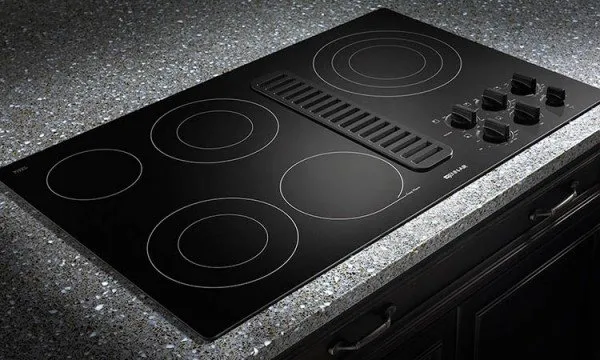
This leads us to another important point—while technically classified as an inductive load due to its use of electricity to create magnetic fields, an induction stove can also be considered a resistive load. This is because the heat generated by the electromagnetic field is ultimately transferred to the cookware and then to the food, making it a form of resistance heating.
While induction stoves can be classified as inductive loads due to their use of electricity to create magnetic fields, their unique design and functionality make them fall into both the inductive and resistive load categories. Hence, induction stoves are indeed considered inductive loads, but they have certain variations and complexities that set them apart from other conventional appliances.
What Does It Mean for a Device to Be an Inductive Load?
An inductive load refers to any electronic device that requires a varying electric current to operate. This type of load is characterized by its ability to store energy in the form of a magnetic field when current flows through it. This stored energy is released back into the circuit when the current stops. Inductive loads typically include devices such as motors, transformers, and solenoids.
How does this apply to induction stoves?
Well, induction stoves use electromagnets to heup pots and pans placed on top of them. These electromagnets create a magnetic field that induces an electric current in the cookware’s base. As a result, the cookware itself becomes part of the circuit and generates heat through resistance.
One important thing to note is that not all electronic devices with magnets can be classified as inductive loads. For example, speakers also use magnets but do not fall under this category because they do not require varying currents for operation. The key factor here is the presence of alternating current (AC) in an electrical device.
So why is it necessary to differentiate between inductive and non-inductive loads? The main reason lies in how these loads affect power consumption and distribution within a household or building. Inductive loads tend to draw more power when first turned on compared to non-inductive ones due to their initial surge of energy flow required for magnetizing components.
This surge can cause voltage drops or fluctuations if too many high-power devices are connected simultaneously. It can also lead to increased electricity bills if not managed properly since these surges require additional electricity to be supplied. This is why it is essential to understand which devices are considered inductive loads and how to effectively distribute them among different circuits.
An induction stove can be classified as an inductive load due to its use of electromagnets and the resulting flow of alternating current. Understanding this distinction can help users manage their power consumption more efficiently and prevent any potential issues with electrical systems.
Understanding Electrical Loads: Resistive, Inductive, and Capacitive Loads
Electrical loads are devices or appliances that consume electricity from a power source. They can be classified into various types based on their characteristics and the way they utilize electrical energy. In this section, we will provide a brief overview of the different types of electrical loads commonly found in households and industries.
What is a Resistive Load?
These are the most basic type of electrical loads that simply convert electrical energy into heat or light without any changes in its form. Examples include incandescent bulbs, electric heaters, toasters, and stoves with heating elements. The resistance offered by these devices is constant and does not vary with changes in voltage or frequency.
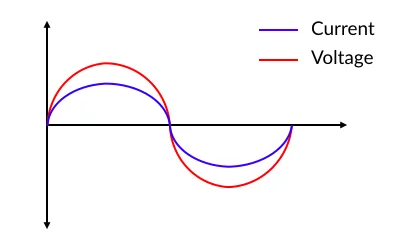
What is an Inductive Load?
Inductive loads are those that require an initial surge of current to start functioning, but once started, they draw steady state power at a lower level. This includes motors, transformers, and fluorescent lights with ballasts. When connected to an AC supply, these loads cause a phase shift between voltage and current due to their inductance property.
What is an Capacitive Loads?
Capacitive loads consist of devices that store electrical energy in an electric field when connected to a power source. They have the opposite effect as compared to inductive loads as they lead to an advance phase shift between voltage and current when connected to an AC supply. Examples include capacitors used in electronic circuits and air conditioners.
What is an Reactive Loads?
Reactive loads combine both resistive and reactive components and can exhibit varying levels of impedance depending on the frequency of the applied voltage. This category includes devices such as induction motors, welding machines, arc furnaces, etc., which have both resistance (R) and reactance (X) components.
What is an Transient Loads?
Transient loads are those that produce sudden spikes or surges of current for short durations during normal operation such as refrigerators starting up or air conditioners shutting down abruptly.
What is an Non-Linear Loads?
Non-linear loads are devices that draw a non-sinusoidal current from the power source, resulting in harmonics and distortion in the voltage waveform. Examples include electronic equipment like computers, TVs, and LED lights.
It is important to note that most household appliances fall under multiple categories of electrical loads. For instance, an induction stove falls under both the inductive and non-linear load categories as it uses an induction coil for heating food and draws a non-sinusoidal current from the power source.
Understanding the different types of electrical loads is crucial for efficient use of electricity and proper selection of wiring, fuses, breakers, etc., to prevent overloading or damage to devices. Additionally, being aware of these types can also help in troubleshooting electrical issues and identifying potential hazards.
Is an Induction Stove an Inductive Load?
After read the definitions of all types of load you well knoe about the inductive load so Now, let’s apply this definition to an induction stove. When we turn on the power for an induction stove, current flows through the copper coil located beneath the ceramic top of the stove. This creates an oscillating magnetic field which induces a current in the ferromagnetic material of the cookware placed on it. The resistance created by this induced current generates heat, which then cooks the food.
Based on this explanation, it may seem like an induction stove should be considered as an inductive load since it utilizes electromagnetic induction for its operation. However, there are several factors that need to be taken into account before making such a conclusion.

Firstly, unlike traditional electric stoves that use resistive heating elements, an induction stove does not draw constant power from the source. Instead, it adjusts its power consumption according to the requirements of each cooking zone and changes made by the user during cooking. This means that even though it uses electromagnetic induction technology for heating purposes, it does not behave like any typical inductive load.
Secondly, most modern household appliances come equipped with advanced electronic circuitry and sensors that regulate their power consumption based on their usage patterns. Induction stoves are no exception and are designed with energy-saving features such as automatic shut-off when not in use for extended periods or when no cookware is detected. These features further differentiate it from traditional inductive loads, which do not have the ability to regulate their power consumption.
While an induction stove does utilize electromagnetic induction, it cannot be classified as a typical inductive load due to its unique design and energy-saving features. It operates differently than other inductive loads and therefore should not be treated as one when considering its impact on household electricity usage.
Inductive vs. Resistive Loads in Induction Stoves
To understand this better, it is important to first differentiate between inductive and resistive loads. Both types of loads are found in various household appliances and devices, including stoves. An inductive load uses a magnetic field to generate electricity, while a resistive load converts electrical energy into heat.
In the case of induction stoves, they do have some elements of both types of loads. The heating element or coil found under the glass-ceramic surface creates an alternating magnetic field when electricity passes through it. This magnetic field induces a current in the ferromagnetic material of the cookware, causing it to heat up and cook food. This process makes induction stoves highly efficient as very little energy is lost during conversion.
However, unlike purely inductive loads such as electric motors or transformers, induction stoves also have some resistance components. The control circuitry and power supply units require resistors for regulating voltage and current flow within the stove. This means that while most of the cooking process is based on electromagnetic induction, there is still some resistance involved.
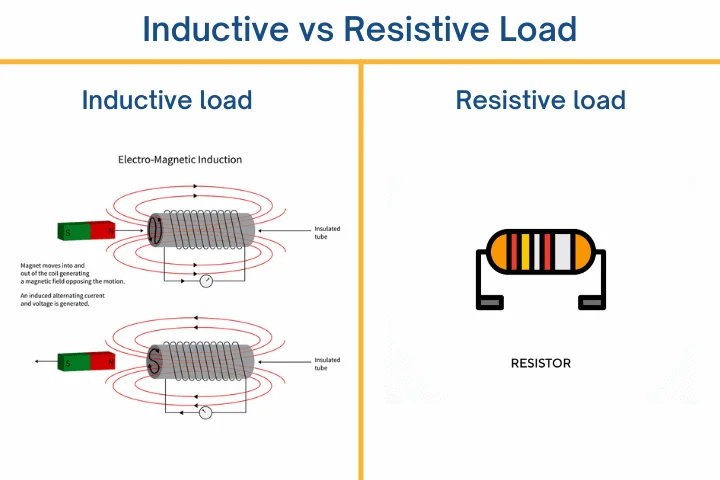
So why does this distinction matter? It comes down to how these different types of loads affect our overall home electrical system. Inductive loads can cause a phenomenon called “power factor,” which refers to how effectively an appliance uses electrical power from your home’s grid. If an appliance has a low power factor (PF), it draws more current from your home’s electrical supply than what actually goes towards powering its intended function – which results in wasted energy.
Fortunately, with modern technology advancements, many newer models of induction stoves come with high PF ratings – meaning they are efficient in converting electricity into useful energy. This is achieved by using capacitors to offset the reactive power from inductive loads, improving the power factor and reducing overall energy consumption.
While induction stoves primarily operate through electromagnetic induction, they do have some resistive components that make them a combination of both types of loads. However, with advancements in technology, newer models have high PF ratings and are considered highly efficient appliances. So if you’re considering upgrading to an induction stove for your kitchen, rest assured that it is a smart choice for both convenience and energy efficiency.
Comparing Inductive and Resistive Loads
| Load Type | Energy Transfer | Examples |
| Inductive | Magnetic fields induce currents | Induction stoves, transformers |
| Resistive | Converts electrical energy into heat | Electric ovens, toasters |
Why Does It Matter if Induction Stoves Are Inductive Loads?
Induction stoves are considered as inductive loads. In simple terms, this means that they consume a significant amount of energy and can have an impact on your electricity bill.
But why does it matter if induction stoves are inductive loads? The answer lies in understanding the concept of power factor. Power factor is the ratio between true power (Watts) and apparent power (Volt-Amps). In simpler terms, it is a measure of how effectively electrical power is being used.
Inductive loads like induction stoves have a low power factor because they require both real and reactive power to operate. Real power is the actual amount of energy consumed by the appliance to perform its function, while reactive power is required for magnetic fields to be created in order for the appliance to function properly. This reactive power does not contribute towards actually cooking your food but still needs to be supplied by the electricity company.
The lower the power factor, the more inefficiently energy is being utilized by an appliance. This leads us back to our initial question – why does it matter if induction stoves are inductive loads?
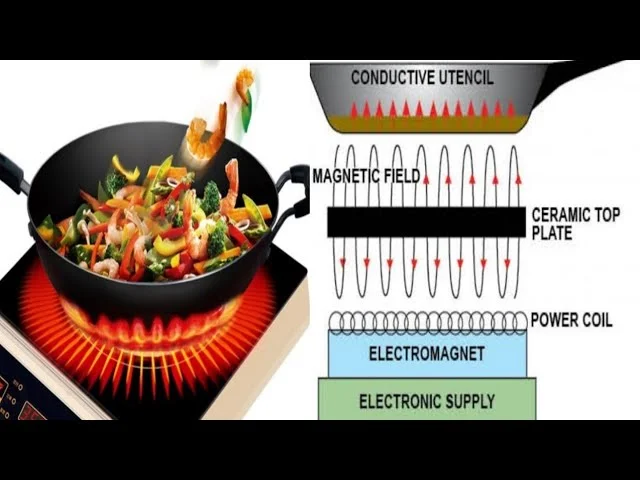
Firstly, having a low power factor means that more energy needs to be generated and transmitted through utility lines compared to what you actually use. This results in higher transmission losses which ultimately lead to higher electricity bills for consumers.
Secondly, utilities often charge industrial or commercial users based on their peak demand or maximum usage within a specific period of time. Induction stoves can cause spikes in demand due to their high wattage usage when turned on initially or when multiple burners are used simultaneously. These spikes can result in additional charges from your utility company.
With increasing concerns about environmental sustainability and reducing carbon footprint, using appliances with low power factors contributes towards energy wastage and carbon emissions. By being aware of the power factor of your appliances, you can make informed decisions to reduce energy consumption and contribute towards a greener environment.
While induction stoves may offer various advantages in terms of cooking performance, it is important to be aware that they are considered as inductive loads with low power factors. This can have an impact on your electricity bill, peak demand charges from utilities, and overall energy efficiency. Being mindful of this information can help you make better decisions for both your wallet and the environment.
Electromagnetic Induction and Induction Stoves
Electromagnetic induction is a phenomenon that occurs when an electric current is generated by varying magnetic fields. This principle plays a crucial role in the functioning of induction stoves, making them one of the most efficient and popular options for cooking.
Induction stoves work by using electromagnetic energy to directly heat the cooking vessel, rather than relying on an external heat source like gas or electric coils. The stove contains a copper coil beneath the ceramic cooktop, which produces an oscillating magnetic field when electricity is passed through it. When a compatible pot or pan is placed on top of the stove, this magnetic field induces electrical currents within its metal base.
These induced currents create resistance and heat up the pot or pan, effectively transferring the energy from the stove to the cooking vessel. This process allows for quick and precise heating, as well as immediate cooling once the power is turned off.
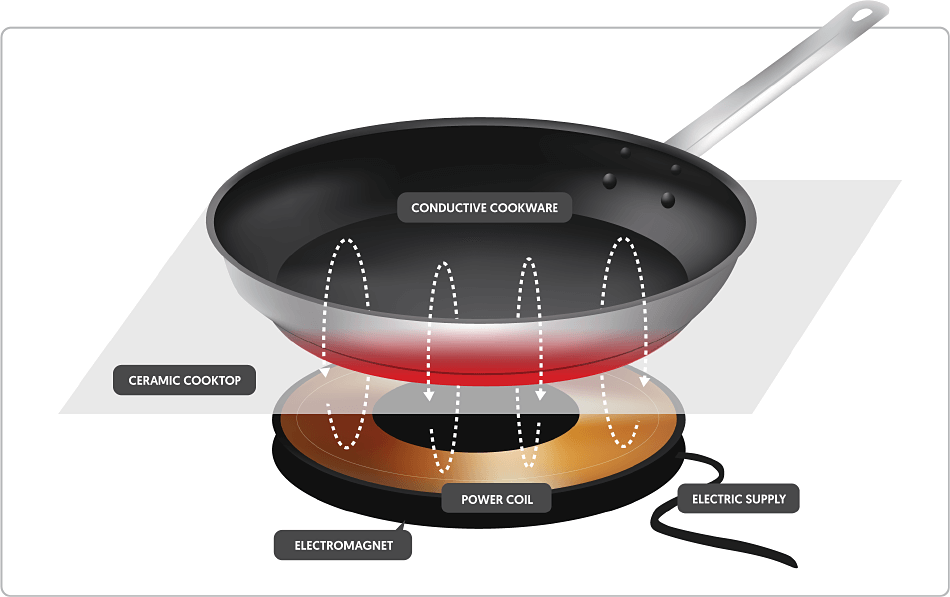
This may means that induction stoves are considered inductive loads. In basic terms, an inductive load refers to any device that requires more power during start-up compared to its continuous operation. This can cause fluctuations in voltage and amperage in electrical circuits.
In the case of induction stoves, they do have high initial power requirements due to their use of electromagnetic energy. However, once the cooking vessel reaches its desired temperature, the power consumption stabilizes at a lower level. Therefore, while technically considered an inductive load during start-up, induction stoves do not pose significant risks to home electrical systems.
Moreover, due to their efficient heating method and ability to quickly reach high temperatures without wasting excess energy like traditional electric or gas stoves do, induction stoves are actually more energy-efficient overall. They also have no open flame or direct contact with heating elements like gas or radiant cooktops do, making them safer and easier to clean.
Another advantage of induction stoves is their responsiveness – they can adjust temperature levels almost instantly, making them ideal for delicate cooking tasks like simmering or sautéing. They also have precise temperature control and can maintain a stable heat level throughout the cooking process.
While induction stoves may be considered inductive loads during start-up, their numerous benefits make them a popular and efficient choice for modern kitchens. Their use of electromagnetic induction not only provides faster and more precise heating but also contributes to energy conservation and safety.
Inductive and Resistive Appliances in the Kitchen
To understand this, we must first understand the difference between inductive and resistive appliances in the kitchen.
Inductive appliances, also known as “motor loads,” use electromagnetic induction to convert electrical energy into mechanical energy. This means that they require a magnetic field to function and typically have moving parts such as motors or fans. Examples of inductive appliances commonly found in the kitchen include refrigerators, washing machines, and dishwashers.
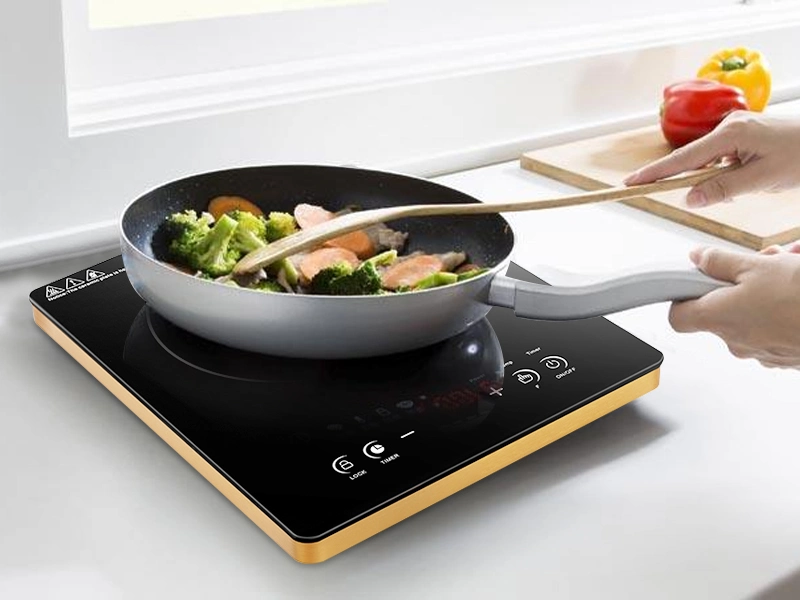
On the other hand, resistive appliances are those that use electrical resistance to produce heat. This includes stovetops, ovens, toasters, and electric kettles. These appliances do not require any moving parts but instead use heating elements made of metal coils or ceramic plates to generate heat.

Now back to our initial question: Are induction stoves considered inductive loads? The answer is yes; they are indeed classified as inductive loads due to their reliance on electromagnetism for operation. Induction stoves work by creating a magnetic field using an electric current that passes through a coil under the surface of the cooktop. When a ferromagnetic pan is placed on top of this coil, it induces an electric current within the pan’s material, generating heat.
However, it is essential to note that although induction stoves fall under the category of inductive loads, they are more energy-efficient than traditional resistive cooktops. This is because they only heat up when there is direct contact with a ferromagnetic material (such as iron), compared to resistive cooktops that continuously draw power even when not in use.
Another factor contributing to induction stoves’ efficiency is their precise and rapid heating capabilities. The magnetic field generated by these stovetops heats the pan directly, resulting in faster and more even cooking. This saves both time and energy compared to resistive stoves that heat the air around the pan before transferring it to the food.
Induction stoves are considered inductive loads due to their reliance on electromagnetism for operation. However, they are more energy-efficient than traditional resistive cooktops, making them a popular choice among eco-conscious homeowners. So if you’re looking to upgrade your kitchen appliances, an induction stove might just be the perfect addition!
Related Articles:
Why Do Induction Stoves Make Those Annoying Clicks? 2024
Why Do Induction Stoves Work Poorly In Low-Power Settings? Info 2024
Why Is My Induction Stove Giving An Electric Shock? Latest Info 2024
Is A Magnetic Induction Stove Better Than A Traditional Stove?
Conclusion
In conclusion, while induction stoves are considered inductive loads due to their reliance on electromagnetic fields for heating, they also have resistive elements in their design. This combination allows them to be highly efficient and precise in cooking. Understanding that induction stoves fall into both inductive and resistive categories helps clarify their impact on energy consumption and power management. Ultimately, their advanced technology makes them a smart, energy-efficient choice for modern kitchens.
FAQs
What makes an induction stove an inductive load?
An induction stove uses electromagnetic fields to induce currents in the cookware, a process that is characteristic of inductive loads.
Does using an induction stove consume more electricity because it’s an inductive load?
While induction stoves are inductive loads, they are still more energy-efficient than gas or traditional electric stoves due to their direct heating process.
Can I use any cookware on an induction stove?
No, only ferromagnetic cookware like cast iron or stainless steel will work with an induction stove.
Are induction stoves better than gas stoves in terms of energy efficiency?
Yes, induction stoves are far more energy-efficient, with an efficiency rate of over 90%, compared to 40-55% for gas stoves.
Are Induction Stoves Purely Inductive Loads?
The short answer is no. While it may seem like induction stoves fall under the category of purely inductive loads due to their use of magnets and coils, there are other factors at play that make them more complex than just a simple electromagnetic device.


